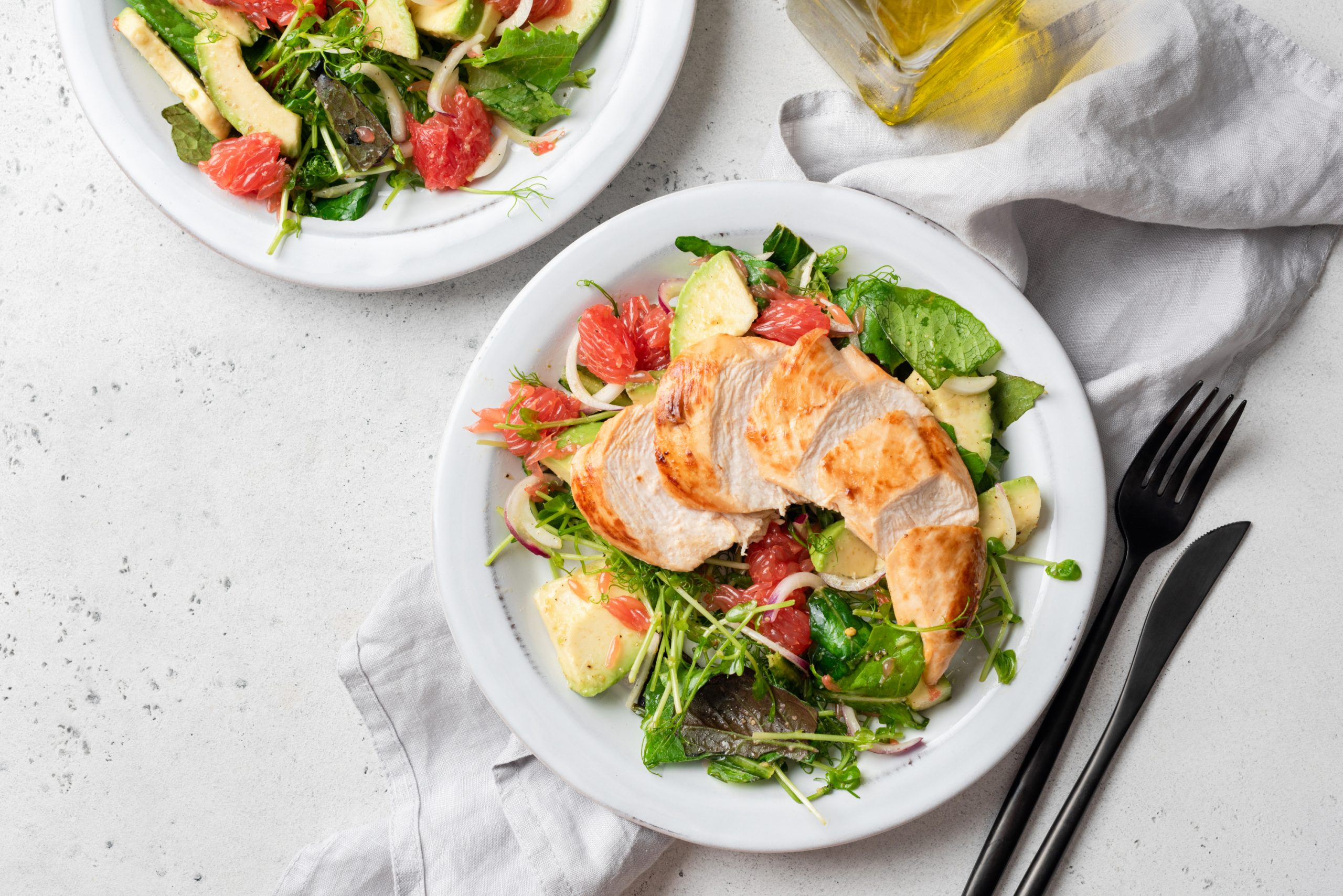Low fibre diet: The best low-fibre foods to eat according to the experts


A low fibre diet is a great plan to help relieve digestive issues. We asked a qualified doctor, dietician and nutritionist for all the need-to-now details of this diet.
Fibre is a substance found in plant-based foods that's packed with plenty of nutrients and minerals that help our bodies work at its best. Yet whilst it helps maintain good gut health for some, it's hard-to-digest nature can be a nightmare for others - particularly those who struggle with bloating or have more serious bowel issues like IBS.
Doctors often ask patients to ditch high fibre foods for a short period to help improve unhealthy bowel symptoms. But it's worth noting that the plan is not for everyone.
Nutritionist Mina Khan explains: "A range of people may choose to follow this diet, but a low fibre diet is primarily intended for those who have bowel problems. Fibre is, however, a really key component of a healthy, balanced diet and is therefore unlikely to suit the average person."
What is fibre?
Fibre, or 'roughage' as it's sometimes known is a plant based carbohydrate which is cannot be absorbed by the small intestine.
"Instead, it travels to the colon (large intestine) and gets broken down by the bacteria that live there," explains registered dietician Lisa Simon. "Fibre is essential for good gut health as it feeds the good bacteria in your colon and this in turn supports a healthy immune system.
There are different forms of fibre to know about. Oats and fruit are classed as soluble fibre whilst whole grains and nuts are insoluble fibre. Then there's resistant starch (bananas, oats, beans), and prebiotic (garlic, onion, leeks, unripe bananas).
Parenting advice, hot topics, best buys and family finance tips delivered straight to your inbox.
"These different categories of fibre are based on how well it dissolves, breaks down and how thick it is (viscosity)," adds Lisa.
Who should eat a low fibre diet?
- Those who experience bowel problems: "Eating a good amount of fibre helps to maintain gastrointestinal health, however high fibre foods can be difficult to digest as they are a form of carbohydrate that cannot be broken down," explains Dr Chun Tang of Pall Mall Medical. One study found that a low fibre diet was beneficial to those with gastrointestinal diseases. The researchers recommended that those following the plan digest a maximum of 10g of fibre a day.
- Those who have been diagnosed with a type of bowel disease: "A low fibre diet can ease diarrhoea and stomach cramps, as well as flare ups of more serious health concerns such as IBS, Crohn’s disease, diverticulitis and ulcerative colitis," Dr Tang adds.
- Someone undergoing a colonoscopy or other bowel surgeries
Whilst the diet is good for those with bowel issues, it should not be adopted by everyone. Both medical experts urge people to consult with their doctor before following a low fibre food plan.
What are the pros and cons of a low fibre diet?
Those following a low fibre diet to help digestive issues will find the plan can help to provide relief from unwanted symptoms.
"One benefit of this diet is that it helps give your digestive system a rest if needed," says Mina. "Fibre takes longer for your body to digest. So consuming less of it for a short period of time has been shown to help with this."
Despite this, Mina doesn't recommend the diet "for more than a few days". This is because adopting a long-term plan could "end up worsening your symptoms and prevent you from getting the nutrients you need."
Fibre is notorious for containing a number of essential nutrients like Vitamin C, magnesium, iron, zinc and Vitamin K. Studies show fibre is important for regulating blood sugar and blood pressure, and can help aid weight loss.
A low fibre diet could also lead to weight gain if followed for a long period of time. This is because you're swapping healthy breads like wholegrain for white, and eating white rice over brown, which tend to be refined and contain more calories.
It's also important to keep your fluids up on this diet. This will help with constipation which can occur from a diet lacking fibre.
Examples of low fibre foods:
- White bread, pasta and rice
- Eggs
- Milk, cheese and yoghurt
- Tinned fruit and vegetables (that have no skin or seeds)
- Fruit and vegetables (well cooked with the skin removed)
- All meats, fish and tofu (minus the skin)
- Desserts: custard, ice cream and milk puddings (as long as these do not contain fresh fruit or nuts)
According to Dr Chun, there are two types of fibre that we need to know about - insoluble and soluble. And these have differing impacts on our body's digestive system.
"Insoluble fibre speeds up digestion, resulting in softer stools and increasingly regular bowel movements," he tells us. "Whereas soluble fibres pass through the body slowly."
On a low fibre diet you want to avoid insoluble fibre foods like whole-wheat, grains, and fruit and vegetable skins. Nuts and oats, which are soluble fibre should also be avoided.

Nutritionist Mina gives us an example of a typical low fibre meal plan:
- Breakfast: Scrambled eggs with white bread
- Lunch: Grilled, skinless chicken with cooked carrots and a skinless baked potato
- Dinner: Baked salmon and white rice
"A couple of examples of snacks you can try throughout the day are plain crackers with slices of cheese or pretzels with peanut butter," she adds.
Foods to avoid when on a low fibre diet
- Brown rice
- Wholewheat pasta
- Whole grain bread
- Skinned fruit and vegetables
- Nuts
- Beans and Pulses
- Ryvita
- Weetabix
- Porridge
"You will need to avoid anything with a skin or pith," explains dietician Lisa Simon. "So tinned satsumas can be eaten but not fresh, and you will need to peel any fruit or vegetables and avoid the skin of a jacket potato."
Hidden fibre in the way of hummus and lentil dips should also be avoided. As should vegetables like sweet corn and pea, because of their outer skin.
"You may also have trouble digesting high fat foods so processed foods should be avoided, along with fatty meats, cheese and cakes/biscuits containing nuts or dried fruit," adds Lisa. "However it is important to say that every person is different. And whereby one person could tolerate a small amount of smooth peanut butter for example, another may not."
With this in mind, it's advised that dietetic supervision is always sought before embarking on a low fibre diet.
How do you re-introduce fibre after following a low fibre plan?
There are a number of steps you can take to slowly incorporate fibre back into your meals.
"Start by leaving skins on fruit and vegetables in different meals and snacks," says Mina. "Then switch from white bread to 50:50 and then onto brown bread. You can also make the move from white rice and pasta to brown or wholemeal."
Dr Chun tells us that you should talk to your GP before deciding to add fibre back into your diet. "After your symptoms settle, consult your doctor to agree on how best to re-introduce fibre into your diet," he says. "If you do start to experience any gastrointestinal symptoms, such as diarrhoea or stomach pain, you should revert back to a low fibre diet until your symptoms settle."
It's important to trust your gut and listen to your body when slowly re-introducing fibre. Mina adds that you should only "go at the pace that you’re comfortable with" and to speak to your doctor if you have any concerns.

Mina Khan is a nutritionist, and qualified pharmacist. She spent 25 years working as a pharmacist before moving into the health food and nutraceuticals industry. Having been brought up with Ayurvedic Medicine, she believes passionately in the use of natural ingredients to help prevent and manage a range of health conditions. She gained her Bachelor of Science (BSc) Pharmacy at the University of Sutherland - and went on to found the nutraceuticals brand, Formulate Health.

Lisa Simon is a registered dietitian with a wide range of clinical experience. She splits her time working in the NHS as dietetic lead in child and adolescent mental health, and working at CQC (Care Quality Commission) registered health care service. Lisa has written a clinical update on diet and fertility for the British Dietetic Association, and is currently writing her first book The Plant-Based Dietitian’s Guide to Fertility. She has also co-authored and co-edited Plant-Based Nutrition in Clinical Practice which was published last year.

Emily Stedman is the former Features Editor for GoodTo covering all things TV, entertainment, royal, lifestyle, health and wellbeing. Boasting an encyclopaedic knowledge on all things TV, celebrity and royals, career highlights include working at HELLO! Magazine and as a royal researcher to Diana biographer Andrew Morton on his book Meghan: A Hollywood Princess. In her spare time, Emily can be found eating her way around London, swimming at her local Lido or curled up on the sofa binging the next best Netflix show.